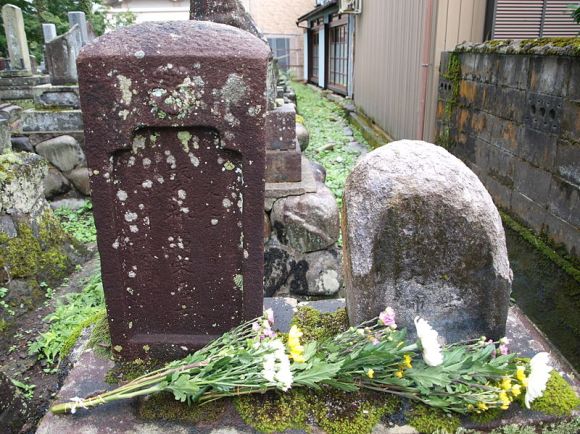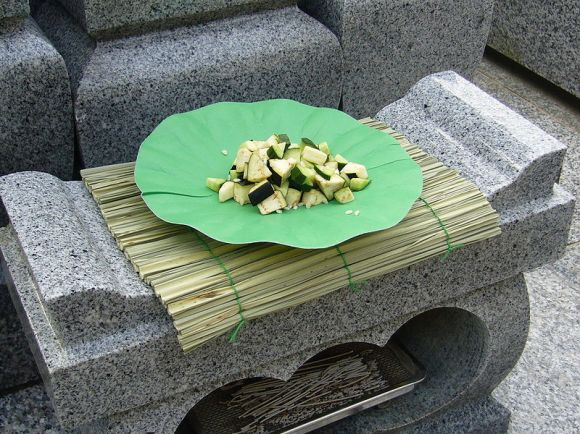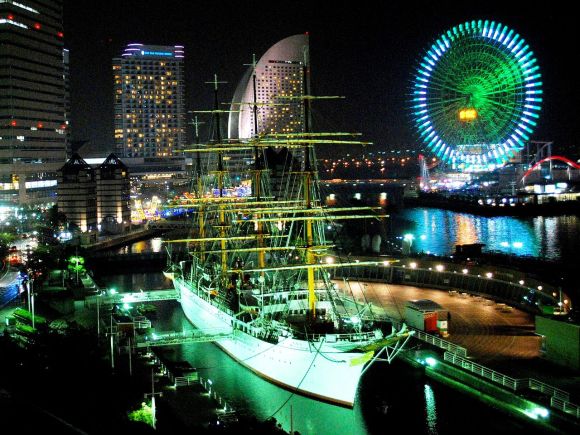
Whenever people ask me what I want to happen after I die, I always tell them I want a Super Mario-themed funeral where, at the end of the ceremony, the Mario death music plays and my casket is launched a few feet up in the air, then allowed fall down into the earth. I’ve always thought that would be a pretty cool way for friends and family to send me off, but the actual location of the funeral – or even really what happened to my body afterwards – has never been all that important to me.
Westerners have surprisingly little ritual when it comes to death. There’s usually a wake or a funeral, and then, if you’re lucky, every couple of years Solid Snake comes by to stand in front of your grave, look grim and deliver a two-hour monologue about the horrors of war. The Japanese, on the other hand, make a point to visit and pay respects to the dead every year through somewhat ritualized ohakamairi, so the location of your grave is an important thing to consider.
So important, apparently, that specialty online grave retailer Ohakamagokorokakaku (“ohakamago”) is considering offering a service to move the graves of loved ones, and recently conducted a survey among Japanese people asking: “Where would you most like to ‘live’ after death?”
Now, since “Mom’s basement,” or “in a bitchin’ Pharaoh tomb” would be the obvious answers for nearly everyone if they were options, the company narrowed choices down to just Japanese cities. Here’s how they rank, based on the number of “I’d probably like to have my earthly remains moved here” responses:
1) Yokohama (Kanagawa)
2) Kamakura (Kanagawa)
3) Kawasaki (Kanagawa)
4) Hachioji (Tokyo)
5) Minato-ku (Tokyo)
6) Sagamiharashi (Kanagawa)
6) Chiba (Chiba)
6) Saitama (Saitama)
7) Meguro (Tokyo)
7) Setagaya-ku (Tokyo)
7) Tama (Tokyo)
7) Ichikawa (Chiba)
(The repeating numbers represent ties)
Okay, so now that we’ve had a little fun with the survey, it’s time for some qualifications:
Despite the tongue-in-cheek survey title, Japanese graves are usually small plots where generation after generation are “entombed” – remember, cremation is the norm in Japan so there aren’t usually bodies to worry about. Plots are often located on or near temple grounds and, if a family has enough money, there’s a large altar-style cement gravestone to mark the place. This is the thing that’s moved when ohakamago talks about moving graves.
So, what the survey is really asking is: Where would you most like your family’s gravestone to be located? In other words, “what city would you most like you and your entire family to live and die in?”
So, Yokohama got first place by a long shot because it’s a beautiful city with convenient transport links, and Kamakura came second because there’s tons of nature and it’s near the ocean. Convenience seemed to play a major factor, as those surveyed said that they live anywhere from 30 minutes to 24 hours (one-way) from their family’s grave site and that they were twice as likely to visit more than once a year if the site was close.
Family gravestone relocation services have existed in the past, often to move graves from derelict graveyards in far-flung locations – graveyards falling into disarray because they lose people to care for them being a somewhat common problem – but what ohakamago is proposing is more of a Kanto area city-to-city relocation service.
Indeed, when the survey asked those who said they lived two-plus hours from their family grave plot, around 26% said imagined it would be necessary to move it some day.
We could go on but we’ll stop here. The survey results go into a whole bunch of other details that, honestly, would put this piece at a few pages long, so we’re not going to go into them. Besides, it’s pretty dry and we don’t want to… bore you to death.
Source: PR Times
Photos: Kazuo Ogasawara, Katorisi, Captan76 via Wikimedia Commons



 Survey Shows 85.2% of Japanese People Are In Favor of Death Penalty, Others Demand “Something Worse”
Survey Shows 85.2% of Japanese People Are In Favor of Death Penalty, Others Demand “Something Worse” What would convince Japanese people to live in a home where there’d been a death or “accident?”
What would convince Japanese people to live in a home where there’d been a death or “accident?” Digital resurrection after death? 63 percent of Japanese and American survey participants say nah
Digital resurrection after death? 63 percent of Japanese and American survey participants say nah Survey ranks Tokyo as the most desirable Japanese prefecture to live in, bumping Kanagawa to #2
Survey ranks Tokyo as the most desirable Japanese prefecture to live in, bumping Kanagawa to #2 Japanese university students reveal the part-time jobs they’d most like to have
Japanese university students reveal the part-time jobs they’d most like to have Starbucks Japan ready to get Year of the Horse started with adorable drinkware and plushies【Pics】
Starbucks Japan ready to get Year of the Horse started with adorable drinkware and plushies【Pics】 We found possibly the quietest Japanese-style hotel in Tokyo’s bustling Shinjuku district
We found possibly the quietest Japanese-style hotel in Tokyo’s bustling Shinjuku district More Than a Capsule Stay: Why Solo Travelers Choose “global cabin Yokohama Chinatown”
More Than a Capsule Stay: Why Solo Travelers Choose “global cabin Yokohama Chinatown” 7 great places to see Mt. Fuji from without having to climb it
7 great places to see Mt. Fuji from without having to climb it Kagoshima conveyor belt sushi chain Mekkemon rises above the rest with its special secret weapon
Kagoshima conveyor belt sushi chain Mekkemon rises above the rest with its special secret weapon New Japanese-made Godzilla movie announced, looks to be first direct sequel since 1999
New Japanese-made Godzilla movie announced, looks to be first direct sequel since 1999 The world’s biggest Muji store opened in Hiroshima, and we went to check it out!
The world’s biggest Muji store opened in Hiroshima, and we went to check it out! Studio Ghibli anime Paper Shadow Art craft kits back in stock in time for the holidays【Pics】
Studio Ghibli anime Paper Shadow Art craft kits back in stock in time for the holidays【Pics】 Free bus tours of Japan’s famous “Disaster Prevention Underground Temple” underway
Free bus tours of Japan’s famous “Disaster Prevention Underground Temple” underway Japanese group to hold fashion show of colostomy bags and other stoma equipment in Paris
Japanese group to hold fashion show of colostomy bags and other stoma equipment in Paris 7-Eleven Japan’s ramen-cooking robot whipped us up a bowl of noodles【Taste test】
7-Eleven Japan’s ramen-cooking robot whipped us up a bowl of noodles【Taste test】 Lacquerware supplier to emperor of Japan and Pokémon team up for new tableware
Lacquerware supplier to emperor of Japan and Pokémon team up for new tableware Cyberpunk anime meets traditional culture in Ghost in the Shell gold leaf Japanese changing screens
Cyberpunk anime meets traditional culture in Ghost in the Shell gold leaf Japanese changing screens Japan may add Japanese language proficiency, lifestyle classes to permanent foreign resident requirements
Japan may add Japanese language proficiency, lifestyle classes to permanent foreign resident requirements Hello Kitty Choco Egg figures are an adorable trip through three periods of Japanese pop culture【Pics】
Hello Kitty Choco Egg figures are an adorable trip through three periods of Japanese pop culture【Pics】 Japan’s otoshidama tradition of giving kids money at New Year’s gets a social welfare upgrade
Japan’s otoshidama tradition of giving kids money at New Year’s gets a social welfare upgrade Starbucks Japan releases new zodiac chilled cup drink for 2026
Starbucks Japan releases new zodiac chilled cup drink for 2026 Can a dirty butthole make you filthy rich in Japan? We’re starting a New Year’s lottery experiment
Can a dirty butthole make you filthy rich in Japan? We’re starting a New Year’s lottery experiment 7-Eleven Japan starts new temporary luggage storage service in over 300 branches
7-Eleven Japan starts new temporary luggage storage service in over 300 branches Disillusionment at Tsukiji’s tourist-target prices led us to a great ramen restaurant in Tokyo
Disillusionment at Tsukiji’s tourist-target prices led us to a great ramen restaurant in Tokyo Starbucks teams up with 166-year-old Kyoto doll maker for Year of the Horse decorations【Photos】
Starbucks teams up with 166-year-old Kyoto doll maker for Year of the Horse decorations【Photos】 Tokyo considering law requiring more trash cans following litter increase in heavily touristed area
Tokyo considering law requiring more trash cans following litter increase in heavily touristed area Tokyo’s Tsukiji sushi neighborhood asks tour groups to stay away for the rest of the month
Tokyo’s Tsukiji sushi neighborhood asks tour groups to stay away for the rest of the month Nintendo’s Kirby now delivering orders at Kura Sushi restaurants, but not in Japan
Nintendo’s Kirby now delivering orders at Kura Sushi restaurants, but not in Japan Tokyo event lets you travel back in time, for free, to celebrate 100 years since Showa era start
Tokyo event lets you travel back in time, for free, to celebrate 100 years since Showa era start Sanrio theme park in Japan announces plans to expand into a Sanrio resort
Sanrio theme park in Japan announces plans to expand into a Sanrio resort Stamina-destroying “Paralysis Noodles” are Tokyo’s newest over-the-top ramen innovation
Stamina-destroying “Paralysis Noodles” are Tokyo’s newest over-the-top ramen innovation Survey asks foreign tourists what bothered them in Japan, more than half gave same answer
Survey asks foreign tourists what bothered them in Japan, more than half gave same answer Japan’s human washing machines will go on sale to general public, demos to be held in Tokyo
Japan’s human washing machines will go on sale to general public, demos to be held in Tokyo Japan’s deadliest food claims more victims, but why do people keep eating it for New Year’s?
Japan’s deadliest food claims more victims, but why do people keep eating it for New Year’s? We deeply regret going into this tunnel on our walk in the mountains of Japan
We deeply regret going into this tunnel on our walk in the mountains of Japan Studio Ghibli releases Kodama forest spirits from Princess Mononoke to light up your home
Studio Ghibli releases Kodama forest spirits from Princess Mononoke to light up your home Major Japanese hotel chain says reservations via overseas booking sites may not be valid
Major Japanese hotel chain says reservations via overseas booking sites may not be valid Put sesame oil in your coffee? Japanese maker says it’s the best way to start your day【Taste test】
Put sesame oil in your coffee? Japanese maker says it’s the best way to start your day【Taste test】 No more using real katana for tourism activities, Japan’s National Police Agency says
No more using real katana for tourism activities, Japan’s National Police Agency says Starbucks Japan reveals new sakura drinkware collection, inspired by evening cherry blossoms
Starbucks Japan reveals new sakura drinkware collection, inspired by evening cherry blossoms Updated cherry blossom forecast shows extra-long sakura season for Japan this year
Updated cherry blossom forecast shows extra-long sakura season for Japan this year Top 10 most desirable Japanese prefectures to live in may show new trend toward small-city living
Top 10 most desirable Japanese prefectures to live in may show new trend toward small-city living How Japanese people deal with death at Nagasaki’s Shoro Nagashi ceremony
How Japanese people deal with death at Nagasaki’s Shoro Nagashi ceremony Should you dip your egg sushi in soy sauce before you eat it? Survey asks Japanese diners
Should you dip your egg sushi in soy sauce before you eat it? Survey asks Japanese diners Top 10 areas in Japan’s capital region where women who live on their own want to live
Top 10 areas in Japan’s capital region where women who live on their own want to live Survey ranks Japanese prefectures by how much people want to continue living there
Survey ranks Japanese prefectures by how much people want to continue living there 7 things Japanese people in international marriages wish they’d known before tying the knot
7 things Japanese people in international marriages wish they’d known before tying the knot Five things that keep Japanese people chained to their jobs
Five things that keep Japanese people chained to their jobs
Leave a Reply